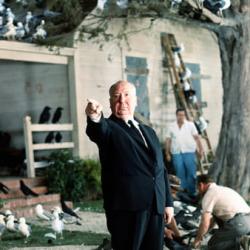
Place:
Museo della Grafica
Start date:
End date:
Pisa is preparing to tremble with fear. From 7 April to 1 September 2019, the Graphic Museum presents an exhibition that investigates the figure of the director of the thrill Alfred Hitchcock (1899-1980).
Curated by Gianni Canova and produced and organized by ViDi, Alfred Hitchcock in the films of Universal Pictures, it presents 70 photographs and special contents from the archives of the American Major that lead the audience backstage to the main Hitchcock films, discovering curious details about the realization of the most famous scenes, on the use of the first special effects, on the actors and on the private life of the English director.
Celebrated as one of the leading and most influential innovators in the history of cinema, Hitchcock is famous for his ingenuity, compelling story lines, camera management, original editing style, the ability to keep the tension alive in every single frame.
The exhibition itinerary analyzes the main Hitchcock masterpieces, produced by Universal Pictures. First of all Psyco (1960), one of his most controversial works that managed to break all the records of takings and made the public escape from the rooms in a panic. An opportunity to see the behind-the-scenes of the metaphysical Motel Bates, learn about the disquieting character of Norman, the dual personality of Marion and the famous shower scene.
A room of the Graphic Museum is dedicated to Gli Uccelli (1963), a film in which he introduced numerous innovations in the field of sound and special effects; with 370 filming tricks, the film took almost three years of preparation due to its technical complexity.
The itinerary in the Hitchcock universe continues with La Finestra sul cortile (1954), with James Stewart playing the photojournalist 'Jeff' Jeffries, confined to a wheelchair due to a broken leg and who, to overcome boredom, spies on the lives of the neighbors from their apartment, to the point of convincing themselves that a crime has taken place in an apartment. The film was a great success; released in August 1954, in May 1956 it had already collected 10 million dollars.
And again, The woman who lived twice (1958), a masterpiece that has become an object of veneration, which tells one of the most distressing love stories in cinema, narrated through an infinite number of extraordinary angles and shots in the most famous places in San Francisco.
The photographic material also casts a glance over other famous films such as Sabotatori (1942), The shadow of doubt (1943), Nodo alla gola (1948), The conspiracy of the innocents (1955), The man who knew too much (1956) , Marnie (1964), The torn curtain (1966), Topaz (1969), Frenzy (1972) and Family plot (1976).
Along the entire perimeter of the exhibition, the visitor is accompanied by a series of video insights by Gianni Canova.
A section is also dedicated to the music that has connoted some of his films, including that of Bernard Herrmann, an American composer who wrote, among others, the famous soundtracks for The Woman who lived twice and Psyco, who were an integral part and fundamental for the construction of the Hitchcockian sense of expectation.
Ideally, the exhibition closes with the famous and fleeting appearances of Hitchcock on the scene. Born as funny gags, cameos eventually became a real superstition. The audience began to wait impatiently and to prevent the viewer from becoming too distracted during the film, the director decided to anticipate them at the very first minutes of the beginning.